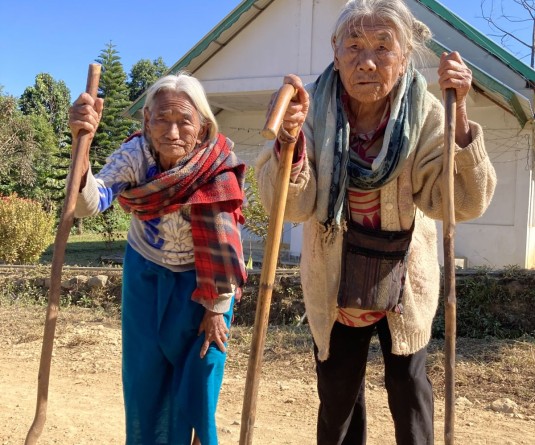
Longjenthi Longkumer
Nagas have historically shared close affinities with their nature, land, water, wildlife and other resources. As indigenous peoples, our ways of life and worldviews have been shaped by the land, forests and water that nurture us. Perhaps the beliefs that underscore such interconnectivity with nature are best symbolized in the Ao-Naga myth of their origin from lungterok , and in the myth of Makhel and the pear tree of unity. Myths and folklores, cultural milieu and animistic beliefs of our ancient past were ecocentric. As custodians of such cultures, Naga youth find their lives seemingly interconnected to the environment that surrounds us.
Traditionally, Nagas revere land as the primary source of life, that nourishes and provides its inhabitants. Respect for the land is therefore symbolized in the Naga customs, traditions, and practices. The land thus isn't only understood as the provider, but also as the core of our culture and the basis of our ethnic identity. In many ways, this is embodied in the belief that one must not leave or ‘betray’ the land they belong to, and must always return to ‘give back’ to the provider. Nagas have largely understood their identity based on the land, and our ethnic consciousness is ‘locational’, meaning that it is based on the geographical expanse which we inhabit. Thus, land continues to be an instrumental marker of the Naga consciousness and identity. Resources that come along with our land - water, minerals, forests, and wildlife, are therefore intertwined with Naga cultural and social realities in many ways.
However, with changing times, there is a shift in Naga youth’s affinity with natural resources and the relationship nurtured. This shift must be scrutinized through our historical context, and requires to be understood within the larger framework of political and social tumult that has largely occupied the region. If one is to look at the natural resources and its unfulfilled potential in Naga areas, the convergence of large-scale political violence, corruption, and arbitrary extraction of resources must be understood.
Nagas, for many decades, have been demanding their right to sovereignty and self-determination. In doing so, the land on which Nagas survive becomes an imperative key, as the need to control their geographical area and its resources serve as the underpinning for their claims to sovereignty. In the decades following India’s independence, counter-insurgency measures deployed by the Indian state have been counterproductive, and the political turmoil that ensued has created a ‘Durable disorder.’ In such a state of turmoil, long-term economic investments are largely absent. But as every society around the world enters the global market, Nagas find themselves at a crossroads. The conundrum lies in the questions relating to who should exploit the resources that essentially belong to the land of the Nagas, and if customary bodies and village councils should overlook management of resources?
Furthermore, the arbitrary extraction of resources in the region, from oil and coal to timber without any institution or framework that seeks to protect both the communities and the environment continues to cause irreversible damage to the ecology of the region. Through illegal mining and extraction, and wildlife hunting, the indigenous communities who are the custodians of the land, are destroying our forests, water, and wildlife. The onus lies on the Naga youth to turn this bleak situation around and take necessary steps towards conservation.
In a militarized society, where state functionaries are largely ineffective, the economy is stagnant, subsistence agriculture is harsh, and political corruption is rampant, the Naga youth are compelled to turn elsewhere for employment opportunities. In essence, they are moving beyond their affinity with the land and resource, causing large-scale out-migration. Thus, it is of paramount importance for the government to forge measures not only to facilitate the youth. but also introduce programs for the holistic development and nurturing of humans and their relationship with the land, forests, wildlife, and water. It is crucial that the Naga youth and government work together to bring a paradigm shift in the way we define progress and development, and fashion a model that is not shaped by western ideals but by our indigenous practices and realities which have always been intrinsically linked to our lands and forests.
Naga youth need to rethink their relationship with their land, forests, and resources, and place it within the context of our long history of violence that has caused much suffering to humans and wildlife alike. While we need to restructure the way we understand our land, and forge in and nurture a deeper understanding and appreciation for it, Naga youth need to find long-term solutions to the social and political undercurrents that have created a chasm between them and their affinity to their land, water, forests, and other resources. Perhaps, we must invoke values and traditions of the bygone days, and shape a future that is equitable, sustainable and just.
1 Ao-Nagas believe that their forefathers emerged out of six stones at a place named lungterok(literally six stones), out of which three were male and three were female.
2 Many Naga communities believe that Makhel was the dispersal site of Nagas, and a pear tree was planted in the village to bear testament to Naga unity. A monolith has been erected at the site with an inscription that reads that the tree is the oldest in Naga history and symbolizes the ‘oneness and unity of Nagas.’
3 TemsulaAo understands Naga identity to be multilayered and describes it as having three components - existential, artifactual and locational.
4 Sanjb Baruah, a political scientist from Assam recognizes the perpetual state of violence, corruption and militarization in the Northeast and uses the phrase ‘Durable disorder’ to describe the state of turmoil.
This is the third prize winner of the Kohima Education Society essay competition in Category B with the theme ‘Affinity of Naga youth with land, water, forests, and wildlife’




